I got some feedback on my writeup of troubles with communications between my server and the Apex and it got me thinking. The short – I’m already using DynDNS.com to create a virtual domain name that points to my dynamic IP address – it uses an updater that runs on my computer to check and update the IP address as needed. Could this service also take an incoming request over port 80, and redirect it to a different port, i.e. 3500, while also directing the request to my dynamic IP? It turns out I can.
You create a free “Web Hop”, i.e. site1.dyndns.com, which in turn points to site2.dyndns.com:3500. Then, you use site2.dyndns.com on a “Host” service to point to the dynamic IP. Since the redirect tags on the port information, it’s carried through on the dynamic IP handling. It works brilliantly in the browser. I thought, after 2 months of being stumped, I had a solution. Of course, my server still fails to grab the content properly from my Apex – I assume it realizes or gets hung up either on the port redirection, or it has to do with carrying the authentication credentials through the webhop and host settings at DynDNS.com. Oh, and I found out it’s going to cost me $25, or $155 a month, to change my host so I can make a request over a port other than port 80. Or I have to find a different hosting provider altogether. This singular aspect of accessing the data on my Apex controller from a webserver is enough to drive me insane.
The other bit of news – we had 2 back-to-back power outages today. The first one I wasn’t awake for…noticed the clocks blinking when I woke up. The second one lasted just under 2 hours. During that time, the MP10 on the battery backup performed admirably. Chances are the tank would’ve been fine either way – it wasn’t a long time to be without power. Still, as I watch the Lightning Maroon swim around this evening, I’m feeling like I’m getting my money’s worth. First power outage we’ve had since we moved to Duluth almost 2 years ago. Feeling pretty smart that I invested in the MP10w ES + Battery Backup!
- About The Lightning Project
- Inventory of F1 PNG Lightning and White Stripe Maroon Clownfish
- F1 PNG Lightning Maroon Clownfish, BZLM1
- F1 PNG Lightning Maroon Clownfish, BZLM2
- F1 PNG Lightning Maroon Clownfish, FW1
- F1 PNG Lightning Maroon Clownfish, LM10
- F1 PNG Lightning Maroon Clownfish, LM11
- F1 PNG Lightning Maroon Clownfish, LM12
- F1 PNG Lightning Maroon Clownfish, LM13
- F1 PNG Lightning Maroon Clownfish, LM14
- F1 PNG Lightning Maroon Clownfish, LM15
- F1 PNG Lightning Maroon Clownfish, LM16
- F1 PNG Lightning Maroon Clownfish, LM17
- F1 PNG Lightning Maroon Clownfish, LM18
- F1 PNG Lightning Maroon Clownfish, LM19
- F1 PNG Lightning Maroon Clownfish, LM20
- F1 PNG Lightning Maroon Clownfish, LM3
- F1 PNG Lightning Maroon Clownfish, LM4
- F1 PNG Lightning Maroon Clownfish, LM5
- F1 PNG Lightning Maroon Clownfish, LM6
- F1 PNG Lightning Maroon Clownfish, LM7
- F1 PNG Lightning Maroon Clownfish, LM8
- F1 PNG Lightning Maroon Clownfish, LM9
- F1 PNG Lightning Maroon Clownfish, MD1
- F1 PNG Lightning Maroon Clownfish, MWP3
- F1 PNG Lightning Maroon Clownfish, WS17
- F1 PNG Lightning Maroon, EC1
- F1 PNG Lightning Maroon, GL1
- F1 PNG White Stripe Maroon Clownfish, BZWS1
- F1 PNG White Stripe Maroon Clownfish, BZWS2
- F1 PNG White Stripe Maroon Clownfish, BZWS3
- F1 PNG White Stripe Maroon Clownfish, WS10
- F1 PNG White Stripe Maroon Clownfish, WS11
- F1 PNG White Stripe Maroon Clownfish, WS12
- F1 PNG White Stripe Maroon Clownfish, WS13
- F1 PNG White Stripe Maroon Clownfish, WS14
- F1 PNG White Stripe Maroon Clownfish, WS15
- F1 PNG White Stripe Maroon Clownfish, WS16
- F1 PNG White Stripe Maroon Clownfish, WS4
- F1 PNG White Stripe Maroon Clownfish, WS5
- F1 PNG White Stripe Maroon Clownfish, WS6
- F1 PNG White Stripe Maroon Clownfish, WS7
- F1 PNG White Stripe Maroon Clownfish, WS8
- F1 PNG White Stripe Maroon Clownfish, WS9
- F1 PNG White Stripe Maroon, EC2
- F1 PNG White Stripe Maroon, FW2
- F1 PNG White Stripe Maroon, GL2
- F1 PNG White Stripe Maroon, MD2
- Lightning Breeding Directive
- Lightning Maroon Clownfish Links
- Home
- About The Lightning Project
- Inventory of F1 PNG Lightning and White Stripe Maroon Clownfish
- F1 PNG Lightning Maroon Clownfish, BZLM1
- F1 PNG Lightning Maroon Clownfish, BZLM2
- F1 PNG Lightning Maroon Clownfish, FW1
- F1 PNG Lightning Maroon Clownfish, LM10
- F1 PNG Lightning Maroon Clownfish, LM11
- F1 PNG Lightning Maroon Clownfish, LM12
- F1 PNG Lightning Maroon Clownfish, LM13
- F1 PNG Lightning Maroon Clownfish, LM14
- F1 PNG Lightning Maroon Clownfish, LM15
- F1 PNG Lightning Maroon Clownfish, LM16
- F1 PNG Lightning Maroon Clownfish, LM17
- F1 PNG Lightning Maroon Clownfish, LM18
- F1 PNG Lightning Maroon Clownfish, LM19
- F1 PNG Lightning Maroon Clownfish, LM20
- F1 PNG Lightning Maroon Clownfish, LM3
- F1 PNG Lightning Maroon Clownfish, LM4
- F1 PNG Lightning Maroon Clownfish, LM5
- F1 PNG Lightning Maroon Clownfish, LM6
- F1 PNG Lightning Maroon Clownfish, LM7
- F1 PNG Lightning Maroon Clownfish, LM8
- F1 PNG Lightning Maroon Clownfish, LM9
- F1 PNG Lightning Maroon Clownfish, MD1
- F1 PNG Lightning Maroon Clownfish, MWP3
- F1 PNG Lightning Maroon Clownfish, WS17
- F1 PNG Lightning Maroon, EC1
- F1 PNG Lightning Maroon, GL1
- F1 PNG White Stripe Maroon Clownfish, BZWS1
- F1 PNG White Stripe Maroon Clownfish, BZWS2
- F1 PNG White Stripe Maroon Clownfish, BZWS3
- F1 PNG White Stripe Maroon Clownfish, WS10
- F1 PNG White Stripe Maroon Clownfish, WS11
- F1 PNG White Stripe Maroon Clownfish, WS12
- F1 PNG White Stripe Maroon Clownfish, WS13
- F1 PNG White Stripe Maroon Clownfish, WS14
- F1 PNG White Stripe Maroon Clownfish, WS15
- F1 PNG White Stripe Maroon Clownfish, WS16
- F1 PNG White Stripe Maroon Clownfish, WS4
- F1 PNG White Stripe Maroon Clownfish, WS5
- F1 PNG White Stripe Maroon Clownfish, WS6
- F1 PNG White Stripe Maroon Clownfish, WS7
- F1 PNG White Stripe Maroon Clownfish, WS8
- F1 PNG White Stripe Maroon Clownfish, WS9
- F1 PNG White Stripe Maroon, EC2
- F1 PNG White Stripe Maroon, FW2
- F1 PNG White Stripe Maroon, GL2
- F1 PNG White Stripe Maroon, MD2
- Lightning Breeding Directive
- Lightning Maroon Clownfish Links
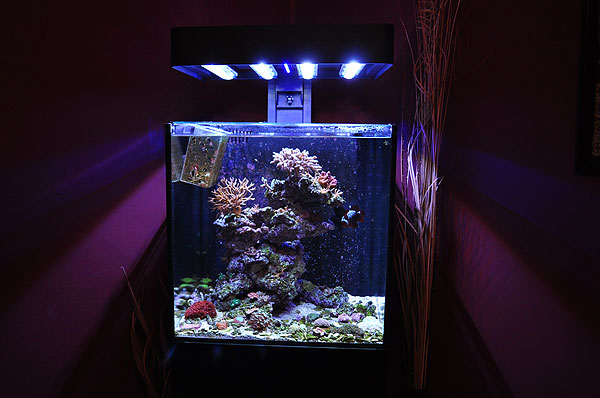 It’s been almost 4 months since the Ecoxotic was set up for the Lightning Maroon…and some SPS! Overall, I’ve been very, very pleased with the tank. Unlike some of the other smaller tanks on the market, I love how easily and brilliantly this one cleans up. Being glass, I can take a razor blade to it if the algae gets out of control. Using 7th Generation Glass Cleaner, I can deal with some really nasty salt drips and spills. But perhaps the best part is how wonderfully the stand cleans up. Once Ike turned me onto Cabinet Magic, well, this tank can be restored to showroom quality in minutes. The only thing I can’t clean up is the back plastic filter box; the moment it got coraline algae growing on it, I couldn’t get it off even with a safe-for-acrylic algae pad.
It’s been almost 4 months since the Ecoxotic was set up for the Lightning Maroon…and some SPS! Overall, I’ve been very, very pleased with the tank. Unlike some of the other smaller tanks on the market, I love how easily and brilliantly this one cleans up. Being glass, I can take a razor blade to it if the algae gets out of control. Using 7th Generation Glass Cleaner, I can deal with some really nasty salt drips and spills. But perhaps the best part is how wonderfully the stand cleans up. Once Ike turned me onto Cabinet Magic, well, this tank can be restored to showroom quality in minutes. The only thing I can’t clean up is the back plastic filter box; the moment it got coraline algae growing on it, I couldn’t get it off even with a safe-for-acrylic algae pad.
One of the questions I got a lot was about the skimmer. People want to know if the built in skimmer really gets the job done. Well, what can I say other than “it works”?

Of course, that was only a couple days after cleaning. You should see it after a few weeks – the sludge in the riser tube gets sickly. Noise? Well, it’s not whisper quiet – most all of the noise comes from the skimmer churning up the air. Everything is pretty sealed up, pretty quiet, and since there are no fans on the lightning, well, this tank runs at a respectable and reasonable level of noise.
Of course, the thing people really want to know is how are the LEDs at growing coral? Well, they are pretty darn good at growing the corals I’ve thrown in there. The Birdsnests are branching like crazy, so light is clearly not an issue. Still, color has been an issue, even on the Birdsnests. Most of the Birdsnests browned out pretty much on introduction, but after a couple months the color was starting to come back. At night, with the actinic Stunner Strip, and corals that are dull are popping.
Well, it turns out that there was a reason that Ecoxotic refined the Panorama units to include more blue. It seems that the actinic blue wavelengths are important not just due to the florescence they create, but they also help actually develop the overall general coloration of the corals. You see, while I really like the “white light” look, it’s good for growth but not so much for color. Of course we kinda already knew about that, which is why no one runs 5500K bulbs anymore, let alone 10K by themselves!

Part of the solution? MORE BLUE! And so begins the a step-by-step addition of a second actinic stunner strip and an all blue Panorama module.
Here’s the stock Panorama setup – one actinic Stunner Strip and four of the Gen 1 Panorama Modules. ALL of the photos before, during, and after, were photographed on manual settings so Shutter Speed (if I recall correctly, 1/60 on tank shots, 1/200 on light shots), White Balance (probably set at none or fluorescent..can’t remember now), Aperture (3.5 on full, 4.5 on closeups) , ISO (400 on tank shots, 200 on light shots?), all are identical to give a true comparison.

Step 1 – reposition the existing stunner strip to the open space on the left. Take the cover off the pigtail and daisy chain on the second stunner strip.
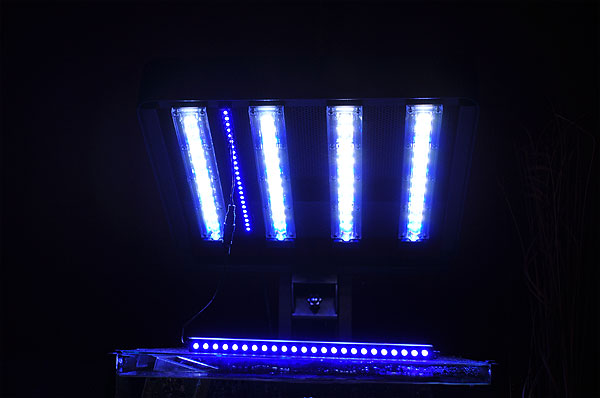
Step 2 – Mount the second stunner strip in the far right space. This was done using the clips and 3M double sided foam tape, as I did with the first one.
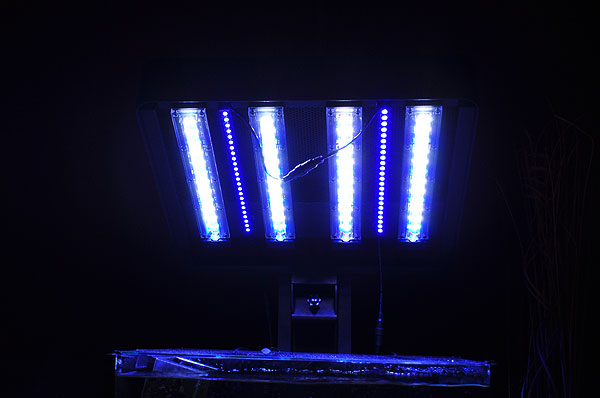
Step 3 – disconnect, and reroute the connection on the stunners to run on top of the Panorama modules. Cap off the pigtail on the second stunner strip and tidy up the loose end with the included cord clips.
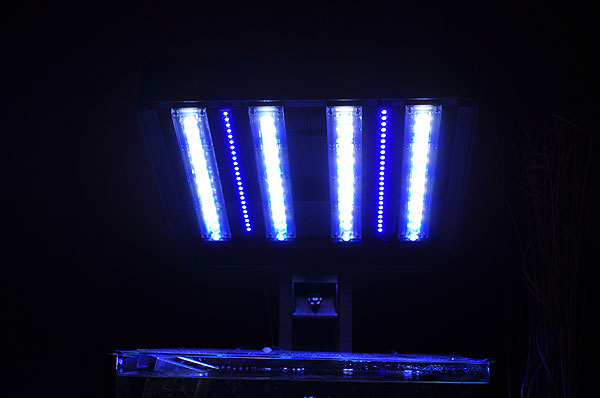
Step 4 – install the Stunner Strip Reflectors. Now, seriously, these are a no-brainer…they just clamp on and are good to go. I’m not sure how much more the add, but the certainly don’t hurt things. Then again, look at how much more things *pop* once the reflectors are installed.

Step 5 – break out the all Blue Panorama unit.
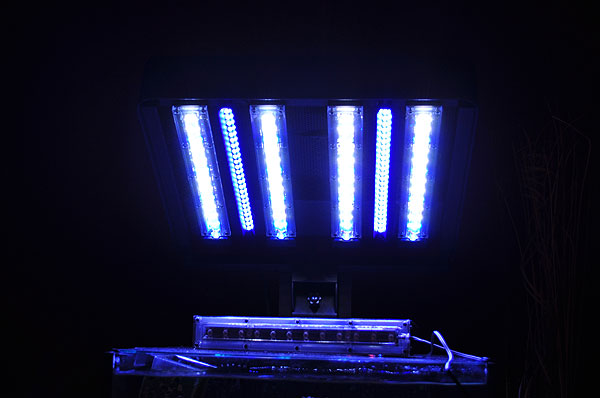
Step 6 – Install the Panorama unit in the middle spot. For this, I once again just used 3M double-sided foam tape.
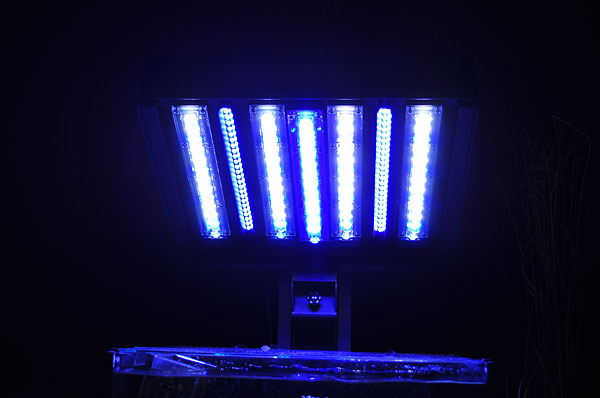
And there it is. “More Blue”!
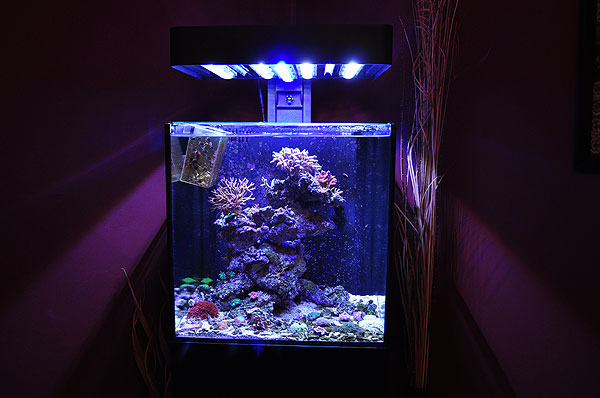
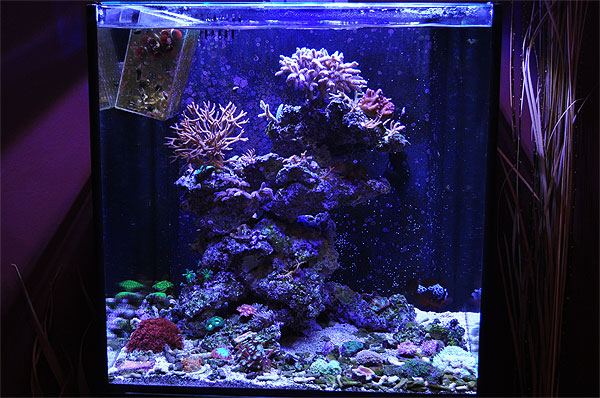
Of course, it’s hard to say just exactly what the difference is until you see the before and after, side-by-side. Before is on the left, after is on the right. Again, the settings for all of these were the same, so the difference is accurate as seen.
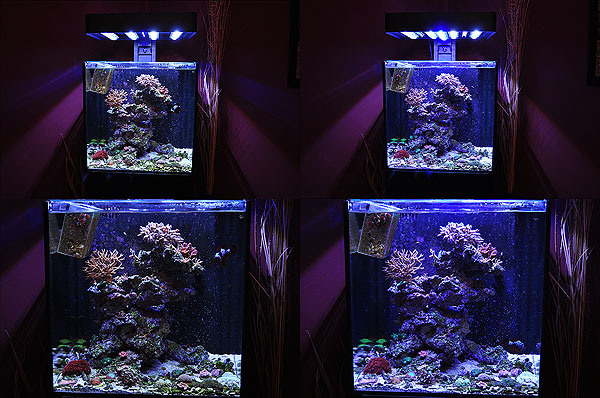
So overall, things are looking good and I expect they’ll only get better. I should again point out that corals were growing well under the stock lighting – this additional blue is to see how much more color I can bring to the mix via lighting. Here’s some closeups after pimpin’ out the lighting a bit…
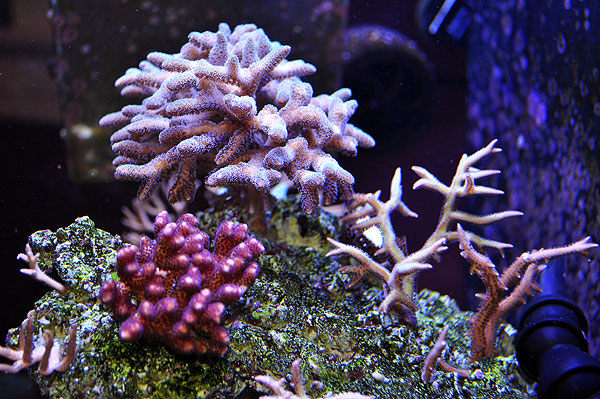
This is a bright red birdsnest I got from Frank, a local reefer. Already shifting purplish after a couple days under the LEDs.
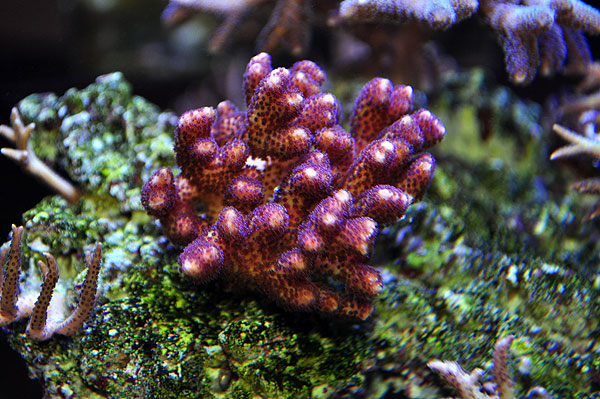
I believe Morgan called this one a Sour Apple Birdsnest..it was a minty seafoam with orange base, but here…well, it’s looking lavender.
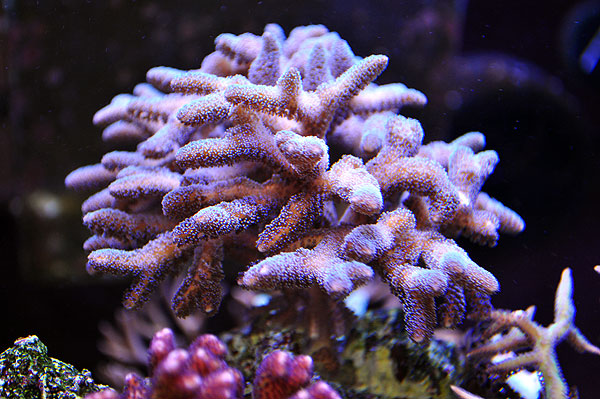
The ORA Red Goniopora is lookin’ sweet!

The Alveopora is lookin’ sweet too!
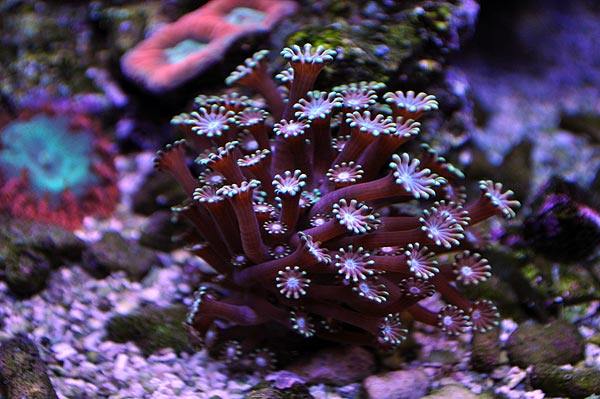
Under the overhang, I’ve placed some Balanophyllias…they grow like weeds, got ’em from Tiffany and can be traced back to a Diver’s Den offering on LiveAquaria.com. I’ll keep sayin’ it – NPS is the new SPS!

That about wraps it up for the moment! My next project – a third introduction of the little male PNG Maroon to the Lightning…will this be the time it works?
Things have gone well for the Lightning Maroon. It is now FULLY recovered from the damage it sustained back in February. The interesting part is that since the introduction of the smaller male, there have been behavioral changes. Specifically, the Lightning undergone a dramatic uptick in digging and rearranging and generally causing issues with the substrate. Thinking about it and thinking about the other Maroons running around – it seems like most of the females running around are diggers. So, is this a sign that the Lightning Maoron Clownfish is turning female? Could be…
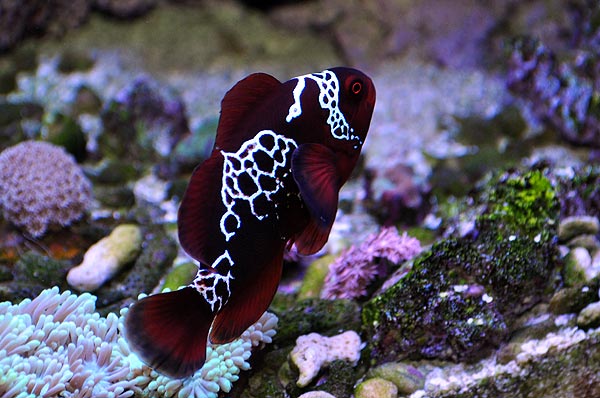
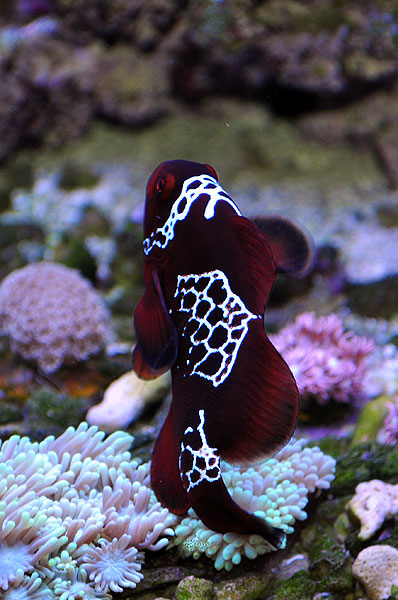
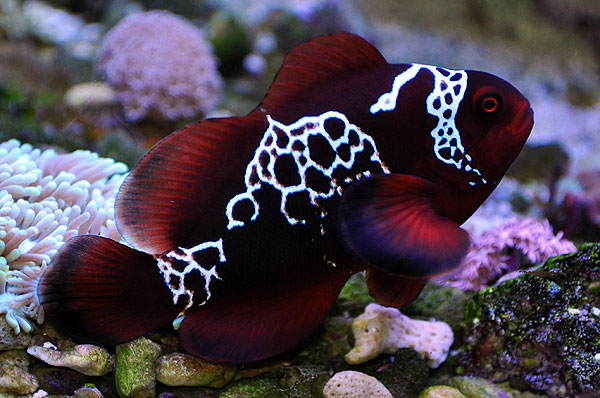
So it’s been a while since I wrote about the additions I’ve made to the stock Ecoxotic 25 gallon LED Aquarium System that houses the Lightning Maroon Clownfish. I alluded to them before, but it’s high time I fill you all in.
Two Little Fishies NanoMag™
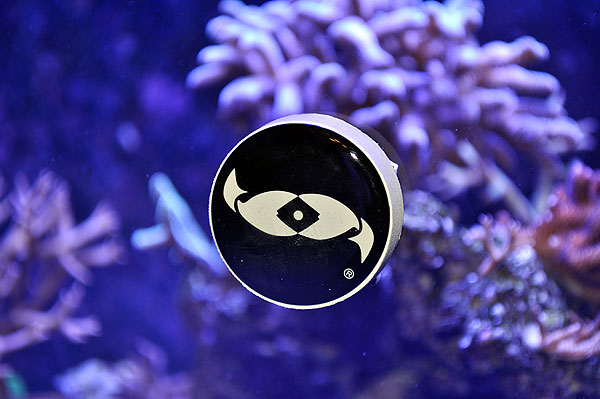
First up is one of my favorite new add ons – the Nano Magnetic Algae Scraper from Two Little Fishies. I used to be a big fan of the Aquarium Systems Twister scrapers for a simple reason – low profile on the inside of the tank. I could have rockwork as close as 0.5″ and still scrape. Well the scaper design from Two Little Fishies has an even lower profile…I don’t think, all said, it would require even 0.25″ of clearance. Maybe even half that! And yet this scraper is STRONG magnetically speaking – I can scrape very fast and the internal portion doesn’t get “detatched” and flutter off into the crevices of my tank. Bar none, for a magnetic algae scraper, this NanoMag™ is the best I’ve used to date for smalles tanks!
Two Little Fishies PhosBan Reactor 150™
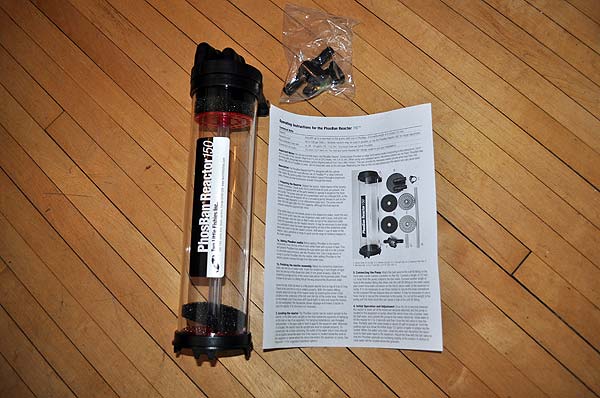
Inexpensive when combined with a small pump, and known to be highly effective as a media reactor, I tried a PhosBan Reactor 150™ on this tank. My installation options were limited – I wound up pumping out of the middle chamber, and cutting off a corner of the “floor” in the third chamber to allow the filters water to drain into the pump chamber. The only realistic spot for this reactor was to hang on the back of the tank. My main use for this reactor was to house carbon.
As of two days ago, I took this reactor off the tank. I can’t say for certain, but it seemed that once I installed this reactor, certain corals in my tank started to go downhill, primarily Favids and other LPS. The growth on my Hulk Clove Polyps trailed off too. My working theory, and it’s just a theory, is that this reactor was so effective that it was “overdoing it” and helping carbon strip the water clean of everything, including possible beneficial elements. Afterall, this is a reactor designed for a much larger tank. So, for now I’ve removed the reactor to see if things come back. I can always return to the less efficient carbon in a bag methodology if I feel a need to run carbon (most all my tanks DO).
Vortech Ecotech MP10w ES with Battery Backup
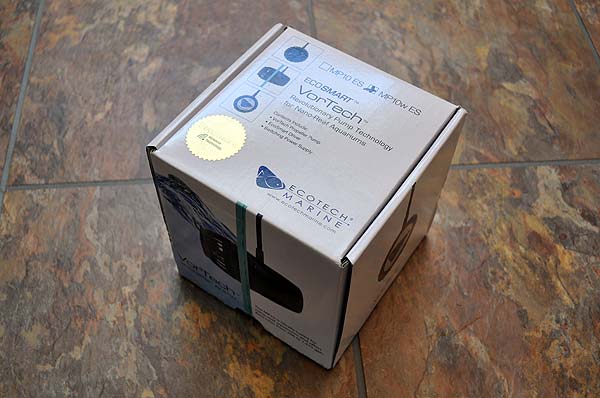
With the stock water pump pushing 400 gallons per hour through the Ecoxotic tank, I questioned the need for additional water circulation. Afterall, when all that water was run through a single outlet, it was enough to move the sand substrate around the tank. Still, the notion of a pump on a dedicated battery backup had me intrigued from a emergency live support standpoint. When some money from speaking and articles piled up and deal on Vortech Pumps was going on, I had to bite the bullet in the interest of the fish.
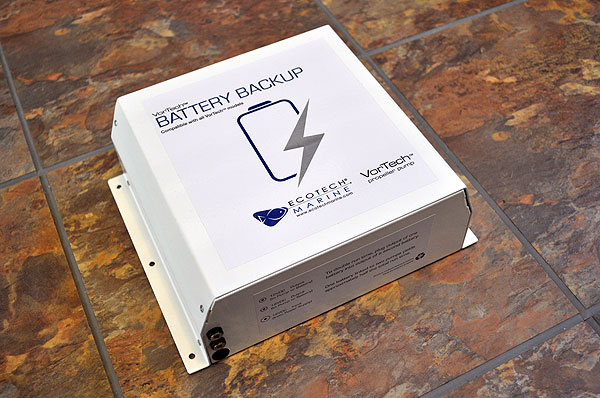
The battery backup is big and heavy. There really wasn’t very much in the way of instructions on how to hook it up either, but eventually I figured out that the controller has a small secondary input for power on the bottom. Easy enough. The pump’s instructions were much more thorough, and once I got the hang of it, setup of the pump was easy.
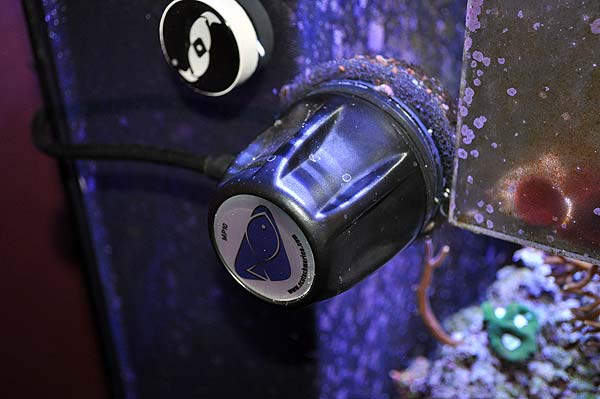
And thus, when I set the pump on my tank and fired it up, I was FLOORED by how much debris and waste it instantly churned up out of the substrate and rockwork. That was all it took to tell me that yes, more flow would not be a bad thing. I rearranged the filter’s return outlets to blow across the back wall of the tank, with the Vortech on the upper back left side panel of the aquarium, blowing water in a direction opposite the pump returns. I did this for a simple reason – when the MP10 is running on minimal settings, I get a nice counter-clockwise flow of water through the tank. When the MP10 is at maximum, it has more than enough power to overcome the main circulation pump and create a clockwise flow pattern. Plus you do get the “turbulence” of two flows colliding when the MP10 is running at moderate levels of flow.
The net result is that all my corals are now benefiting from increased flow but it’s not TOO MUCH for the tank to handle. I’ve set up a “standing wave” in the tank using the short pulse wave mode after clearing this with Ecoxotic (Vortech’s recommendation is to check with a tank manufacturer before making a wave, as some tanks aren’t strong enough to hold the shifting water mass). I now normally run the MP10 in “Reef Crest” mode with the range set to maximum, but will sometimes engage in “Nutrient Transport Mode”. It seems like if I keep it in NTM for too long, the corals don’t open as much, so RC is my default setting.
The battery backup works without a hitch and with the single MP10 can supposedly keep water moving for over 24 hours. If I had to be critical, I’d say I wished that I had finer control over the wave settings of the single MP10 – I can’t get quite the right waving timing on this little tank. I also wish that the MP10w ES had a truly random mode where it would shuffle through ALL the various modes. That said, there is a way to accomplish that feat, if I want to by an add-on component for my other main addition…
Neptune Systems Apex Lite Aquarium Controller
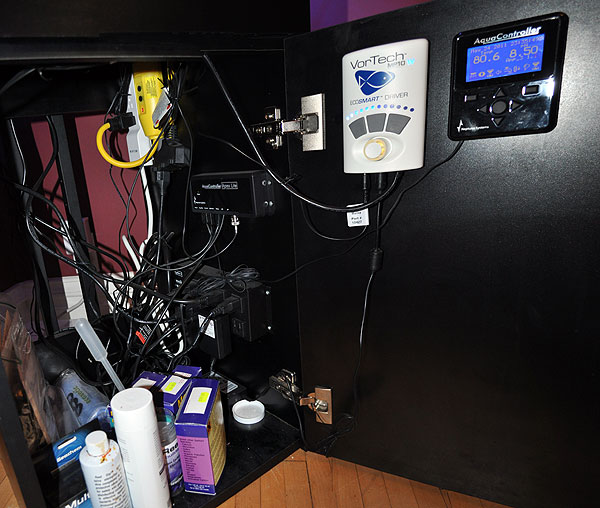
In all my years as a saltwater enthusiast, I had never used an aquarium controller. It seems to me that controllers are often better suited for larger, complex systems that have a lot going on, a lot that could go wrong, and sensitive / delicate processes (like ozone usage) that are far better managed through constant monitoring.
Well, my interest in a controller for the Lightning Maroon’s tank was first sparked by Jay, my SPS guru who’s helping me with the coral care. I did my homework and in the end, I opted for a Neptune for a very simple reason – I sent an email asking for a phone call, and I got it in 20 minutes. The other controller companies out there…nope. Maybe a generic email back. Let that be a lesson to anyone with a business who’s reading this. During business hours, most people expect a pretty timely response to an online inquiry…customer service can still earn your business. It earned mine.
As I looked into it deeper, all sorts of benefits came up. You have a fallback on your heater, so if your heater’s thermostat fails in the on position, the controller can shut it off. You get better temperature monitoring in general too without batteries to replace. What really opened up my eyes to the true potential of a modern controller is it’s ability to connect to the internet, and to send email alerts should something be on the fritz based on the parameters you set. As it turns out, with the Neptune controller, if you set it up right it could, in theory, even email you in the event of a power outage (assuming your internet connection isn’t affected as well). For a guy who goes on the road a lot to speak about aquariums, this certainly had my interest. Of course, the REAL kicker for me was the ability to expose real time data over the internet. My ultimate and yet frivolous main goal? Put the Lightning Maroon’s tank specs on the website in real time.
Of course, it’s that last goal that failed miserably for a few reasons. First, on the Neptune’s side of things, the data feeds are password protected. That’s not a terrible problem in itself, but it does seem excessive to lock down this generic readout data with password protection. The actual problem is that the credentials you use to access the data feeds are the same credentials you use to access the rest of the controller. So for someone who wants to do one of those 3rd party signature generators, you actually have to provide them with your full credentials in order for them to pull data from your Neptune controller. That’s a HUGE security issue in my book as you’re trusting a 3rd party to a) not meddle with your controller and b) keep your credential information secure and protected so that yet another party doesn’t come along and hack it. I find this current system of password protection unnecessary and a big security risk given what most hobbyists will want to do with a data feed from a controller. I’ve strongly, adamantly suggested that in the next firmware update, either these data feeds be made public, or they utilize separate credentials from the rest of the controller’s capabilities. Either one circumvents the problem of giving the keys to a stranger.
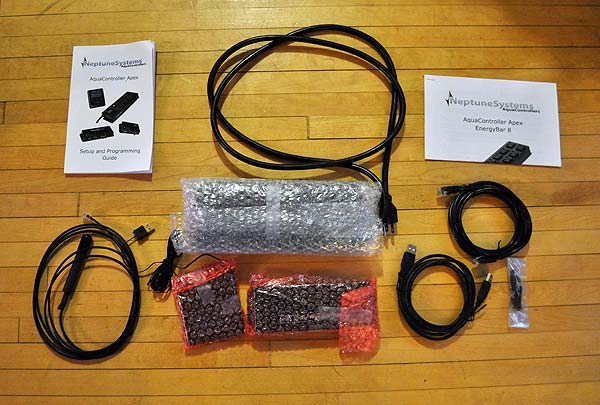
All of that said, I’m an internet guy and I figured I’d be running this on my own server anyways. That meant credentials wouldn’t be an issue. Ah, but get ready for this one. Your average home ISP likely blocks incomming traffic over most or all ports. So even if you use a dynamic domain service to handle IP address changes, it doesn’t solve the entire problem. You still need to find a port you can enter through. In my case, the standard port 80 is blocked, as are most other ports. I did find one that worked…up in the 4 digit range. “Almost there”.
Of course, nope. Because my hosting provider only allows me to request data over port 80, the very same port that my ISP blocks. So while I can access my data feeds through a browser from another city over a port like 4500, my server won’t. The solutions are simple and mind blowingly aggravating. I either change my home ISP package to become a business customer ($60 more per month) at which point I can have port 80 traffic, or I migrate ALL my websites from one hosting package to another (again paying more)…which I have to manually do apparently. The last solution is to go back to one of those 3rd party signature generators offered to aquarists, but then I have to risk having my controller’s credentials in 3rd party hands. I simply can’t take that risk when the controller handles the life support for the only Lightning Maroon Clown in captivity.
In the end, the controller is great at handling things like my light timing. The alarms work like a charm. When I get things configured properly, it will even tell me when the power goes out. The feed modes are very useful. There is even a module that will control my Vortech MP10w ES if I want, which would give me the random or programmatic switching between modes I wanted but can’t get through the Vortech itself. It would also allow me to dail-down the MP10 when I run my “water change” feed timer that currently shuts everything off (Vortech when off runs off the battery backup instead, which I don’t want to wear out and overuse if I don’t really need to). I probably won’t tap into the seasonal capabilities although in other circumstances I could find them very useful. Probe calibration was pretty easy.
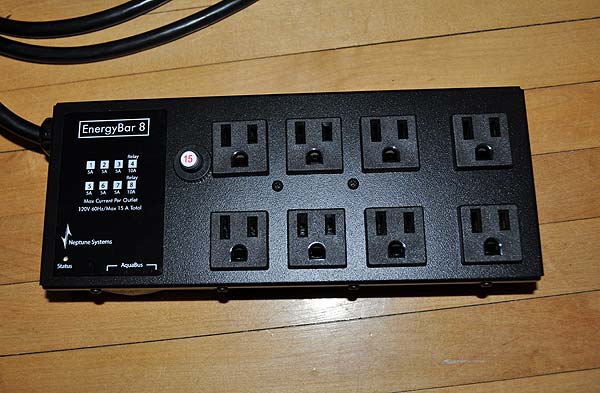
I did have problems with small water pumps not turning off when the power was shut off to their outlet, but I found out that is a known issue with the power bar and if you use the right TYPE of outlet on the power bar, it’ll work. That certainly could use improvement. Still, the biggest FAIL is that the data-rich features I wanted to tap into wound up being a bust, and I’m terribly frustrated in that regard. No one tells you any of this up front, so know now that you need to know how to set and configure your router, as well as all this other stuff, and even when you do it perfectly, it may not work. Now, none of that is Neptune’s fault parsay, but a whole slew of features I want to utilize are off limits unless I want to pay through the nose for hosting or internet.
Eshopps Magnetic Probe Holder
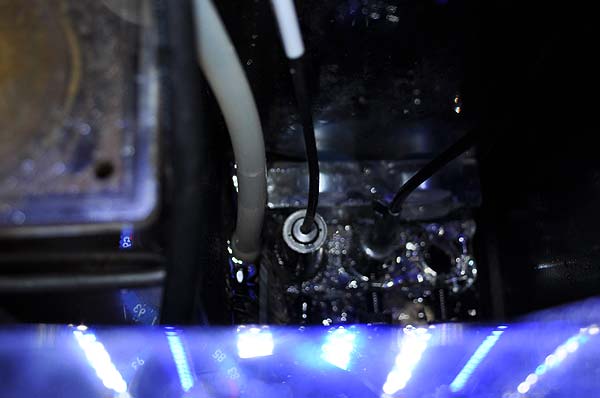
Considering that controller probes really aren’t supposed to be completely submerged, simply hanging them in the tank isn’t a good route to go. Enter the Eshopps magnetic probe holder, which happens to fit almost perfectly in the middle chamber of the Ecoxotic’s filtration system.
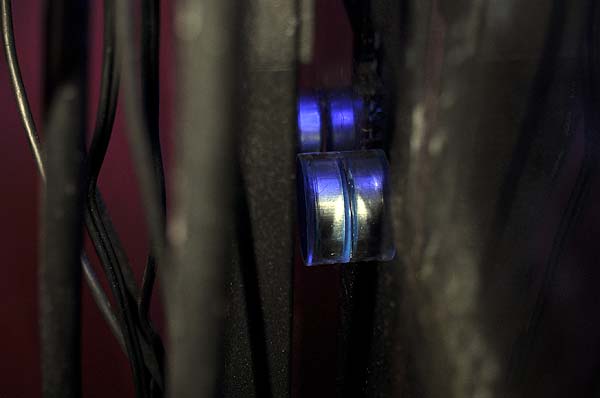
Being magnetic, I can move it up or down if need be. Of course, once in place, the probes are held in by a screw, which can easily be loosened to take out the probes for servicing.
I’ve been watching the tank these past few weeks and looking at coral health. I probably should be keeping track of actual water changes, but I haven’t. The other night, I did one and reserved the water for a pre-water change and post-water change test comparision. Here’s how things shook out.
PRE water change:
Specific Gravity (refractometer) – 1.025
Alkalinty (Seachem) – 4.5 meq/L
Magnesium (Salifert) – 1470 ppm
Calcium (Salifert) – 460 ppm
Nitrate (Salifert) – approximately 7 ppm
POST water change:
Alkalinity (Seachem) – 4 meq/L
Magnesium (Salifert) – 1485 ppm
Calcium (Salifert) – 470 ppm
Nitrate (Salifert) – approximately 5 ppm
What I can’t quite figure out is why Calcium and Magnesium have jumped so much higher. I’ve been dosing LESS with the C-Balance 2 part as pH has routinely been hitting 8.4 for brief periods, and have dosed maybe twice now with Seachem’s Reef Advantage Calcium instead. That along can’t account for the drastically higher levels. I’m wondering if either uptake has dropped off. I say that, but some of the Birdsnests seem to be putting on a lot of growth and finally starting to color up. Another working theory is that I opened a new box of Seachem’s Reef Crystals salt. I wonder if maybe the formulation of the new batch is different than the prior batch. If there’s inconsistencies there, a couple water changes could certainly be all it takes to dramatically alter the baseline chemistry of the tank.
I’ll have to keep an eye on things further. Very, very curious. I don’t yet have the coral coloration I want, especially out of the Birdsnests. I’m also continuing to have a few bleaching issues with the various Favids in the tank, which I think stems from aggression between corals combined with an increased “bulldozer” mentality on the Lightning Maroon’s part – I consider that a good sign for the Lightning Maroon. It was never a digger…none of my “male” Maroond dig. The females however do. Is this a sign that a sex change is underway?
Not much else to say, just a short snippet of the Lighting Maroon flirting with a ORA Red Goniopora colony while being bathed in a sliver of afternoon Easter sunlight.
So, Tuesday night, guess who spent the night in the tank? That’s right, the little male PNG Maroon. No additional damage, but the little male was banished to the area between the specimen cup and the glass of the tank…only “safe place” for him. On the one hand, happy it wasn’t dead…this is a big step forward. On the other hand, wishing the Lightning Maroon wasn’t being such a bully!
As promised, finally, the process of pairing up the Lightning Maroon with a known male PNG Maroon is finally underway.
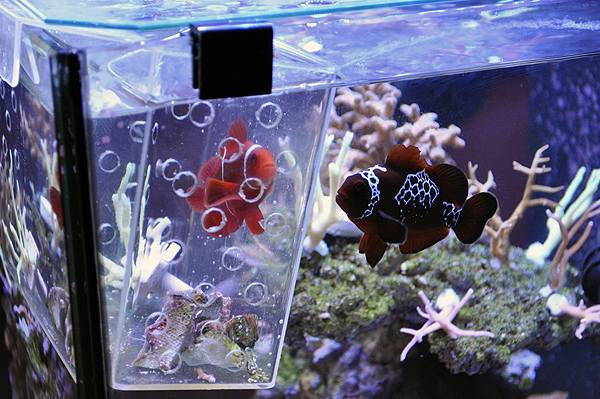
To put it bluntly, without a doubt I am convinced that for the last year, the Lightning Maroon has been male. Why? Well, first, watch this video of the female Gold Stripe Maroon that used to be paired with the White Stripe Maroon above. The new small Gold Stripe Maroon was introduced to the female Gold Stripe less than a minute before this video was taken. Watch the interactions.
Next up, here’s the Labrador Maroon, trying to be paired with a “female” White Stripe Maroon. The deal here – a local hobbyist thought this maroon to be female, and was trying to pair it with a smaller maroon. The two maroons fought incessantly, and this I believe was the second attempt (the first one ended up with a dead maroon). Both Maroons wound up in my possession.
I already paired the “male” with a larger White Stripe Maroon (you may recall Lucy, a lone wolf female living in a sump that Debbie in the twin cities contributed). The first go round it didn’t work so well, but after a week or two of living in a container, the male was released and all went well.
So the “female” meanwhile, has been living in another container in QT and was moved in with the Labrador in a container either Wednesday or Thursday this week. Unlike the interactions you’ll see with the Lightning Maroon, the Labrador didn’t show any interest in the maroon until it was released. And the “female” maroon certainly wasn’t acting like a female…scared to death perhaps, it instantly went into classic submissive behavior. Unfortunately, in all the commotion, the Dwarf Angels started attacking too, and ultimately, after 10 minutes, the “female” Maroon was returned to her container to “lick her wounds”.
Also tried pairing up the PNG “extras” today again. You may remember months ago I showed a video of the reaction – here it is from August 31st
And here is the same pair April 10th, 2011. I’ve been feeding the male in the “cage” only once per day, while the other fish gets feed at least 2-3 times per day. The size difference is starting to stack up, and you’ll notice how the interactions have “changed”.
Still, in the end, this pair isn’t ready…by the last video, the “female” has resorted to occasional pot shots directed at the “male”. I suspect that given more time, and a greater size difference, this should result in a stable pairing.
In ALL of the examples, the reactions have not been as violent as the initial reaction of the Lightning Maroon to the smaller PNG Maroon, which wasn’t even released into the tank but was held back in a drilled specimen cup.
Obviously this pairing isn’t a home run. It’s a relationship that’s going to need a lot of counseling and support. As I was headed to the NWRS / UPMMAS frag swap on Friday, I reminded Renee that the small, normally colored Maroon needed to be in the cup. Sometime on Saturday, she was feeding our 11th month old son when she heard some commotion in the tank behind her. She scrambled downstairs, grabbed the first nets she could find, and returned the small PNG Maroon to the specimen cup. In the span of 3 minutes, this is what the Lightning Maroon had done.
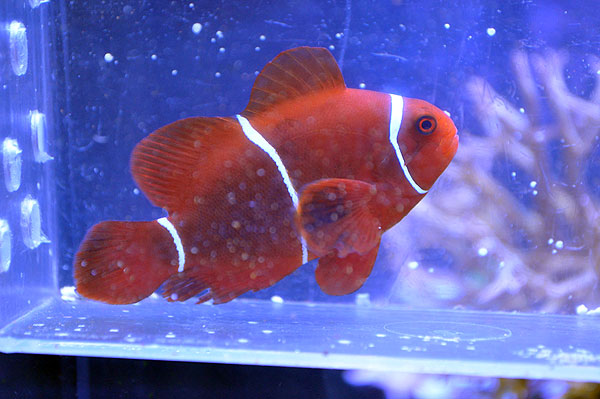
Once again, it goes without saying that everything goes wrong when you’re out of town! Thankfully Renee was quick witted and addressed the problem. Of course, Sunday evening I walked up to the tank and the little one jumped out of the cup again…the interactions I saw weren’t quite as bad perhaps. The little male PNG Maroon made all the conciliatory and submissive gestures, but the Lightning Maroon still is not a receptive mate. This is going to take a fair amount of time yet, and as most of you should realize by now, pairing up White Stripe Maroons is NOT easy.
Real quickly, I have tons of videos uploading to Youtube but they’re taking all freakin’ day (I shot a lot this weekend). Lots of interesting stuff on the pairing front coming. In the meantime, I’m doing a water test…here’s where we sit:
Temp (Neptune) – 79.5F
pH (Seachem) – 8.2
pH (Neptune) – 8.25
Alkalinity (Seachem) – 4.25 meq/L
Nitrate (Salifert) – 2 ppm
Calcium (Salifert) – 420 ppm
Magnesium (Salifert) – 1215 ppm
So I find myself still feeling like my Magnesium levels are staying “low”. I’ve even been adding Seachem’s Magnesium to my RO/DI water before adding in the salt (Reef Crystals) in the hopes of raising the initial magnesium levels a bit. I haven’t really been doing too too much in the way of water changes here…I think I did only my second or third 5 gallon water change this last week when adding in the new corals from Upscales and Seahorse Northwest.
No time to post more now, but I wanted to put it on record that the pairing process started today. I receive a shipment of coral from Upscales in Portland, which included 2 massive Birdsnests from Jim Blegen of Seahorse Northwest and a stunning little Gold Stripe Maroon that Travis had at his shop. Ironically it was the arrival of the Gold Stripe Maroon that kickstarted all of this today (as you may recall, the PNG Maroon I selected to be paired with the Lightning Maroon is a known male, currently spawning with a large Gold Stripe Maroon). Well, the new little GSM was destined for the large GSM, so it pushed out the PNG Maroon, who is now in a drilled specimen cup being terrorized by the Lightning Maroon. Vids, pictures, lots of stuff coming, probably by Sunday.
Recent Comments